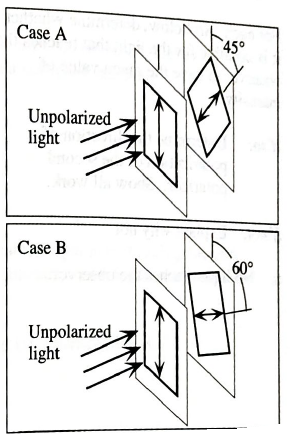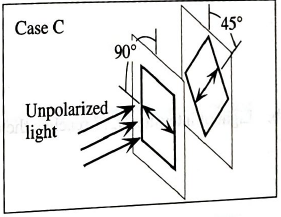
Identical beams of light are incident on three different pairs of (ideal) polarizers. The double arrow drawn on each polarizer represents its direction of polarization.


- Suppose that the incident light in each case were unpolarized.
Rank the three cases (A−C) according to the intensity of the light transmitted past the second polarizer, from largest to smallest. If for any case no light is transmitted past the second polarizer, state that explicitly. Explain your reasoning.
The ranking of intensity of light after passing through the second polarizer in each case.
Answer to Problem 1aTH
B<A=C
Explanation of Solution
Introduction:
The intensity of light passing through a polarizer depends directly on square of cosine of the angle. Smaller the angle between the two polarizer, greater will be the intensity of light passing through the second polarizer.
The angle between the two polariser is smallest in case A. hence the intensity of light is greatest in case A.
For case A and case C, the value of square of cosine of the angle between two polariser is same. Hence the intensity of light is same in case A and case C.
The angle between the two polariser is greatest in case B. hence the intensity of light is smallest in case B.
Conclusion:
Hence the intensity of light after passing through second polarizer is same in case A and case C and is greater than the intensity of light in case B.
Want to see more full solutions like this?
Chapter 25 Solutions
Tutorials in Introductory Physics
Additional Science Textbook Solutions
Conceptual Integrated Science
Physics: Principles with Applications
Physics for Scientists and Engineers: A Strategic Approach with Modern Physics (4th Edition)
Physics (5th Edition)
Life in the Universe (4th Edition)
University Physics (14th Edition)
- In order to rotate the polarization axis of a beam of linearly polarized light by 90.00, a student places sheets P1 and P, with their transmission axes at 45.0° 90.0°, respectively, to the beam’s axis of polarization. (a) What fraction of the incident light passes through P1 and(b) through the combination? (C) Repeat your calculations for part (b) for transmission-axis angles of 30.00 and 90.0 , respectively.arrow_forwardA cylindrical solenoid of radius R and height h consists of N windings. There is a current through the windings, and this current increases with time as I=αt, where α is a constant. b. Determine the magnitude of the Poynting vector at a radial distance r=R from the center of the long center axis of the solenoid. Express your answer in terms of magnetic constant μ0, α, R, h, N and t. c. Use the result of the previous part to derive an expression for the power input to the solenoid as a function of time. Express your answer in terms of π, magnetic constant μ0, α, R, h, N and t. d. Using the formula for the inductance of an ideal solenoid, calculate the power from the rate of change of the stored magnetic energy. Express your answer in terms of π, magnetic constant μ0, α, R, h, N and t.arrow_forwardConsider a plane, monochromatic, electromagnetic wave traveling in a homogeneous medium.Its electric field vector E in units of (V/m) is given in the image below where t(sec), and x(m). a) Derive an expression for the magnetic field B->b) Find the direction of the the magnetic field B-> from part a.arrow_forward
- Initially unpolarized light is sent along the z-axis into a system of three polarizing sheets placed perpendicular to the z-axis and whose polarizing angles with respect to y-axis are 22º (first sheet), 89º (second sheet), and 56º (the last sheet). What percentage of the initial light intensity is transmitted by the system? Express your answer as a percentage, to at least one digit after the decimal.arrow_forwardA sinusoidal plane electromagnetic wave of frequency 20 GHz moves in the positive y direction and its electric field is directed along the z-axis. The amplitude of the electric field is 10 V/m. The start of time is chosen so that at t = 0, the electric field has a value +(10 V/m)k at the origin. a. Write the function that describes the electric field of the wave as a function of position y and time t. Hint: Among other things, you need to decide whether to use a cosine or sine function, and whether a negative sign is needed inside and/or outside the sine/cosine function. b. Explain why the electric field is not a function of the x or z coordinate. c. Find the function that describes magnetic field of the wave as a function of position y and time t.arrow_forwardWhat minimum path length is needed to introduce a phase shift of 205° in light of wavelength 566 nm? (Give your answer in nm.) What phase shift will that path difference you calculated in part (a) introduce in light of wavelength 799 nm? (Give you answer in degree.)arrow_forward
- In the figure, initially unpolarized light is sent into a system of three polarizing sheets whose polarizing directions make angles of θ1 = 40°, θ2 = 20°, and θ3 = 40° with the direction of the y axis. (a) Draw a sketch of the situation that shows polarizations of light after each polarizer. (b) What percentage of the light’s initial intensity is transmitted by the system? Answer: 3.1%arrow_forwardFor the polarizers in the figure, suppose the incident light is linearly polarized, the transmitted intensity (through both polarizers) is 0.2×I0, and the axis of the second polarizer makes an angle θ=51.5° with the axis of the first polarizer. What is the angle (in degrees) the initial direction of polarization makes with the first polarizer? (Insert the number of degrees without unit.)arrow_forwardA beam of polarized light is sent into a system of two polarizing sheets. Relative to the polarization direction of that incident light, the polarizing directions of the sheets are at angles u for the first sheet and 90° for the second sheet. If 0.10 of the incident intensity is transmitted by the two sheets, what is u?arrow_forward
- A beam of polarized light with intensity I0 and polarization angle θ0 strikes a polarizer with transmission axis θTA. What angle θ should be used in Malus's law to calculate the transmitted intensity I1? This process is illustrated in the figure (Figure 2), where the polarization of the light wave is visually illustrated by a magenta double arrow oriented in the direction of polarization, the transmission axis of the polarizer is represented by a blue double arrow, and the direction of motion of the wave is illustrated by a purple arrow. θ0 θTA θTA−θ0 θTA+θ0 (θTA−θ0)/2 What is the polarization angle θ1 of the light emerging from the polarizer? θ0 θTA θTA−θ0 θTA+θ0 (θTA−θ0)/2arrow_forwardDescribe the field lines of the induced magnetic field along the edge of the imaginary horizontal cylinder shown below if the cylinder is in a spatially uniform electric field that is horizontal, pointing to the right, and increasing in magnitude.arrow_forwardWhat is the physical significance of the Poynting vector?arrow_forward
 Principles of Physics: A Calculus-Based TextPhysicsISBN:9781133104261Author:Raymond A. Serway, John W. JewettPublisher:Cengage Learning
Principles of Physics: A Calculus-Based TextPhysicsISBN:9781133104261Author:Raymond A. Serway, John W. JewettPublisher:Cengage Learning University Physics Volume 3PhysicsISBN:9781938168185Author:William Moebs, Jeff SannyPublisher:OpenStax
University Physics Volume 3PhysicsISBN:9781938168185Author:William Moebs, Jeff SannyPublisher:OpenStax Physics for Scientists and Engineers: Foundations...PhysicsISBN:9781133939146Author:Katz, Debora M.Publisher:Cengage Learning
Physics for Scientists and Engineers: Foundations...PhysicsISBN:9781133939146Author:Katz, Debora M.Publisher:Cengage Learning
 Glencoe Physics: Principles and Problems, Student...PhysicsISBN:9780078807213Author:Paul W. ZitzewitzPublisher:Glencoe/McGraw-Hill
Glencoe Physics: Principles and Problems, Student...PhysicsISBN:9780078807213Author:Paul W. ZitzewitzPublisher:Glencoe/McGraw-Hill




